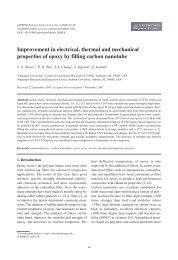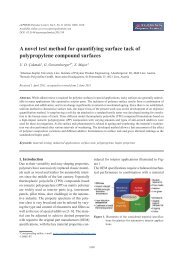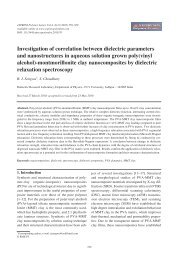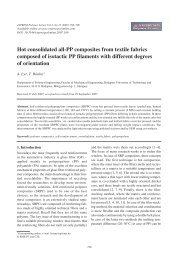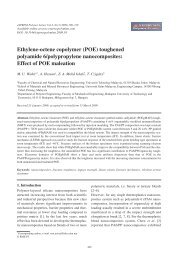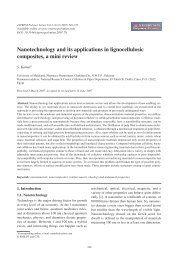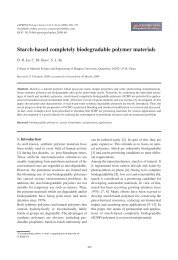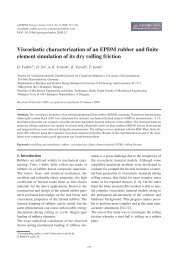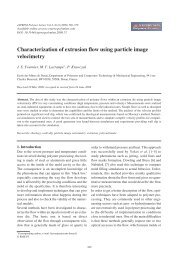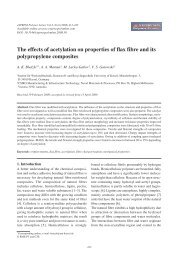Synthesis and characterization of a novel bisphthalonitrile ...
Synthesis and characterization of a novel bisphthalonitrile ...
Synthesis and characterization of a novel bisphthalonitrile ...
Create successful ePaper yourself
Turn your PDF publications into a flip-book with our unique Google optimized e-Paper software.
Cao et al. – eXPRESS Polymer Letters Vol.1, No.8 (2007) 512–518<br />
Figure 7. The TGA curves <strong>of</strong> the polymer a) in N 2, b) in<br />
air<br />
343.38 <strong>and</strong> 354.06°C, respectively. The temperatures<br />
at weight loss 5 <strong>and</strong> 10% in nitrogen atmosphere<br />
are 437.50 <strong>and</strong> 504.59°C <strong>and</strong> in air<br />
atmosphere are 434.63 <strong>and</strong> 504.29°C, respectively.<br />
The char yield at 800°C under nitrogen is 73.65%<br />
<strong>and</strong> at 600°C under air is 78.66%. In Table 2, the<br />
thermal properties <strong>of</strong> BPNBZ are summarized <strong>and</strong><br />
compared to other phthalonitrile. The thermal properties<br />
<strong>of</strong> BPNBZ under nitrogen are as well as or<br />
decrease slightly than the other two monomers, but<br />
there is a significant improvement <strong>of</strong> the BPNBZ<br />
thermal properties under air than the other two.<br />
Therefore, the BPNBZ can be used for making<br />
heat-resistance high performance composites.<br />
3.3. The rheological behavior<br />
Figure 8 is relationship between rheological behaviors<br />
<strong>and</strong> temperature under curing process <strong>of</strong> <strong>bisphthalonitrile</strong><br />
containing benzoxazine. Two transitions<br />
<strong>of</strong> G’ appear from 200 to 300°C <strong>and</strong> two cross<br />
Figure 8. The rheological behaviors <strong>of</strong> the BPNBZ under<br />
non-isothermal curing<br />
points <strong>of</strong> G’ <strong>and</strong> G” were observed at 242.7 <strong>and</strong><br />
276.1°C, respectively. The G” has two apparent<br />
peaks. The first peak ranges from 200.9 to 242.7°C,<br />
<strong>and</strong> the second peak ranges from 242.7 to 276.1°C.<br />
The Delta curve appears two sharp peaks; the temperature<br />
<strong>of</strong> peak top is 230.7 <strong>and</strong> 276.1°C respectively.<br />
As these results, the former suggests primary<br />
polymerization <strong>of</strong> oxazine ring-opening, <strong>and</strong><br />
the later suggests the <strong>bisphthalonitrile</strong> polymerizations<br />
<strong>of</strong> nitrile groups. So, it means that the <strong>bisphthalonitrile</strong><br />
containing benzoxazine had completely<br />
cured with two-stage polymerization mechanisms<br />
which are consistent with the DSC results.<br />
4. Conclusions<br />
The <strong>novel</strong> <strong>bisphthalonitrile</strong> containing benzoxazine<br />
(BPNBZ) has been synthesized using bisphenol-A,<br />
4-aminophenoxylphthalonitrile <strong>and</strong> paraformaldehyde.<br />
The structure <strong>of</strong> the monomer was supported<br />
by FTIR spectroscopy, 1 H-NMR, <strong>and</strong> 13 C-NMR<br />
Table 2. summary <strong>of</strong> TGA results<br />
Monomer<br />
Nitrogen<br />
Air<br />
T 5% T 10% Char yield [wt%] 800°C T 5% T 10% Char yield [wt%] 600°C<br />
437 505 73 434 504 78<br />
414 505 73 378 420 0<br />
544 596 80 390 450 75<br />
517




